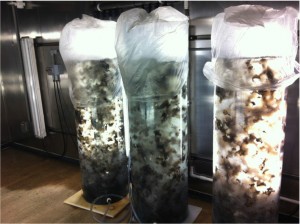
Globally, the seaweed industry is worth over $6 billion per year (FAO, 2012), with the majority of production coming from cultured plants in Asia (99.7%). Marine macroalgae are cultured and wild harvested around the world for food and non-food uses. Maine has a traditional wild harvest seaweed fishery that has been operating at a relatively small, cottage scale for over 50 years, producing high value food, supplements, and extracts from a wide range of species in the Gulf of Maine. While sea vegetables have been primarily restricted to small, specialty “health food” markets in the past, there is growing recognition of their ‘functional food’ properties, and they are becoming more popular in Western cultures as a sustainable, nutritional, local option. As awareness of the health benefits of sea vegetables rises, so does demand. Maine, especially, is seeing a great increase in demand due to quality concerns in sea vegetables sourced from the Pacific (e.g., water quality in China, radioactive concerns from Fukushima in Japan), creating an opportunity for the development of a sustainable sea vegetable aquaculture industry.
 Maine has a unique opportunity to develop a sea vegetable aquaculture industry, with its cold, clean waters, extensive coastline, and existing fishery and aquaculture industries and infrastructure. Interest in sea vegetable farming is growing in the state, as it may represent an opportunity for diversification for traditional fishermen or sea farmers. Sea vegetable aquaculture has the advantage of occurring mainly in the winter months, in the “off season” for lobstering and recreational boating, and consists of simple, submerged long line systems. Marine macroalgae also play an essential role in integrated aquaculture, providing a photosynthetic, inorganic extractive crop to shellfish or finfish farms, part of an ecologically based model that can help take up excess nitrogen and improve water quality. Sea vegetables require no fertilizer or freshwater to grow, produce oxygen, take up carbon, and provide habitat and structure for other organisms. Seeded lines are produced in a land based nursery, then placed out to grow naturally on leased sea farms for approximately 6-8 months.
Maine has a unique opportunity to develop a sea vegetable aquaculture industry, with its cold, clean waters, extensive coastline, and existing fishery and aquaculture industries and infrastructure. Interest in sea vegetable farming is growing in the state, as it may represent an opportunity for diversification for traditional fishermen or sea farmers. Sea vegetable aquaculture has the advantage of occurring mainly in the winter months, in the “off season” for lobstering and recreational boating, and consists of simple, submerged long line systems. Marine macroalgae also play an essential role in integrated aquaculture, providing a photosynthetic, inorganic extractive crop to shellfish or finfish farms, part of an ecologically based model that can help take up excess nitrogen and improve water quality. Sea vegetables require no fertilizer or freshwater to grow, produce oxygen, take up carbon, and provide habitat and structure for other organisms. Seeded lines are produced in a land based nursery, then placed out to grow naturally on leased sea farms for approximately 6-8 months.
The 2014-2015 growing season is the fifth season for sugar kelp (Saccharina latissima) aquaculture in Maine, with new native crops under development. There are a number of companies and individuals that are leading the way to develop a new seaweed aquaculture industry in Maine. Ocean Approved, LLC, in Portland, Maine, was the first commercial kelp farm in the United States, and has since expanded its farms and evolved its product line-up, a variety of cut, blanched, and frozen ready-to-eat products (Conley, 2014). Maine Coast Sea Vegetables, a traditional wild harvest sea vegetable company, is playing an important role in multi-species research and development, as they look for a sustainable source of product for the future. Maine Fresh Sea Farms in Bristol is a new seaweed farm that is working to develop a multi-season, multi-species farm model, and there are a number of other individuals and companies that are experimenting with sea vegetable culture and marketing.
MAIC is playing a critical role in the development of this new industry, supporting a variety of research and development projects that have helped to grow kelp on shellfish farms along the coast, started new farms, provided seed to new farmers, supported research for the development of new crops, supported development of a sea vegetable R&D nursery at the University of Maine’s Center for Cooperative Aquaculture Research in Franklin, and helped to support the first Maine Seaweed Festival.
